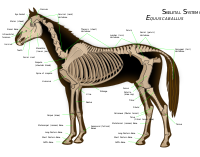
Photo from wikipedia
ABSTRACT Kangaroo rats are small bipedal desert rodents that use erratic vertical jumps to escape predator strikes. In this study we examined how individual hind limb joints of desert kangaroo… Click to show full abstract
ABSTRACT Kangaroo rats are small bipedal desert rodents that use erratic vertical jumps to escape predator strikes. In this study we examined how individual hind limb joints of desert kangaroo rats (Dipodomys deserti) power vertical jumps across a range of heights. We hypothesized that increases in net work would be equally divided across hind limb joints with increases in jump height. To test this hypothesis, we used an inverse dynamics analysis to quantify the mechanical output from the hind limb joints of kangaroo rats jumping vertically over a wide range of heights. The kangaroo rats in this study reached maximal jump heights up to ∼9-times hip height. Net joint work increased significantly with jump height at the hip, knee and ankle, and decreased significantly at the metatarsal–phalangeal joint. The increase in net work generated by each joint was not proportional across joints but was dominated by the ankle, which ranged from contributing 56% of the work done on the center of mass at low jumps to 70% during the highest jumps. Therefore, the results of this study did not support our hypothesis. However, using an anatomical model, we estimated that a substantial proportion of the work delivered at the ankle (48%) was transferred from proximal muscles via the biarticular ankle extensors. Summary: In jumping kangaroo rats, the ankle joint is responsible for the highest work output; however, a substantial proportion of this work is being transferred over the biarticular ankle extensors.
Journal Title: Journal of Experimental Biology
Year Published: 2018
Link to full text (if available)
Share on Social Media: Sign Up to like & get
recommendations!